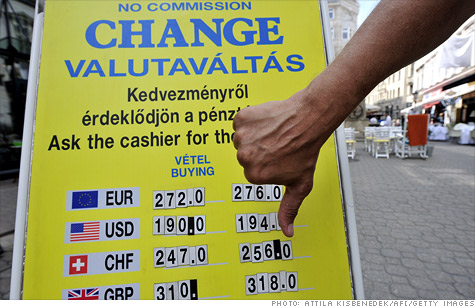Search News

An employee at a foreign exchange office in Budapest shows how they feel about the euro debt crisis.
NEW YORK (CNNMoney) -- The sovereign debt problems in Europe have roiled financial markets around the world.
With little relief in sight, investors are growing worried about the possibility of a credit crunch similar to the one that gripped the international banking system three years ago.
"We're seeing signs of it starting already," said Patrick Bolton, a professor of finance at Columbia University. "The mechanism and the players are different but there's a very similar dynamic to what we saw in 2008."
Shares of European banks came under attack last week following reports that an unnamed bank borrowed billions of dollars from an emergency facility at the European Central Bank.
The fear is that banks are having trouble obtaining short-term funding from sources such as commercial paper and money market funds. In 2008, those pools of liquidity dried up and lending ground to a halt as banks reported massive losses on mortgage-backed securities.
However, the traditional indicators of bank-to-bank lending are not flashing red just yet. LIBOR, the London Interbank Lending Rate, has ticked up about 6 basis points over the last few months, but remains at levels well below the peak of the crisis in 2008.
Economists were quick to point out that there are several key differences between 2008 and the threat posed by the current situation in Europe.
"We will probably not see a reprise of 2008," said Sara Johnson, an economist at IHS Global. "Financial institutions and central banks are better prepared this time, and the sources of the problems are more transparent."
Unlike the previous crisis, when banks' exposure to mortgage-backed assets was unknown, Johnson said the threat to Europe's banking sector is more quantifiable.
She added that the ECB is unlikely to let a major financial institution fail. The collapse of Lehman Brothers was one of the main triggers of the 2008 crunch.
"One problem has been that euro leaders, including the ECB, have been a step or two behind as the sovereign debt has unfolded," said Johnson. "But I think they now have the determination to do what's necessary to recapitalize the banks."
Jay Bryson, an economist at Wells Fargo Securities, pointed out that European banks aren't likely to suffer as big of a hit now as banks did in 2008.
He said he exposure European banks have to the sovereign debt of the five most troubled euro zone economies runs in the hundreds of billions of dollars. And U.S. banks are relatively insulated from the sovereign debt of Greece, Portugal, Ireland, Spain and Italy.
By contrast, Bryson said banks around the world wrote down roughly $2 trillion in the wake of the sub-prime mortgage bust.
Bryson added that banks took 100% haircuts in 2008, meaning the value of the troubled assets on their books was completely erased. In Europe, he said, "they're looking at haircuts of about 30% to 40%."
Still, he was reluctant to rule out the possibility of another credit crunch.
"There is some sense that it could happen," said Bryson. "But it won't be as bad as it was in '08. Banks aren't levered up like they were back then."
Bryson said banks that depend on short-term loans called commercial paper and other wholesale funding sources are among the most vulnerable. But banks that are funded mainly by deposits should be safe, he added.
Gus Faucher, director of macroeconomics at Moody's Analytics, said the risk of a credit freeze is much greater in Europe than in the United States. But he added that a banking crisis could tip Europe's economy back into recession, which could ripple across the globe.
There is now a roughly 40 percent chance the US economy could slip back into recession, according to Faucher.
While many economists say the crisis in Europe is the biggest threat, the US economy is facing many other headwinds, he added.
"Europe certainly isn't helping, but many of our problems are home grown," said Faucher. ![]()
| Overnight Avg Rate | Latest | Change | Last Week |
|---|---|---|---|
| 30 yr fixed | 3.80% | 3.88% | |
| 15 yr fixed | 3.20% | 3.23% | |
| 5/1 ARM | 3.84% | 3.88% | |
| 30 yr refi | 3.82% | 3.93% | |
| 15 yr refi | 3.20% | 3.23% |
Today's featured rates: